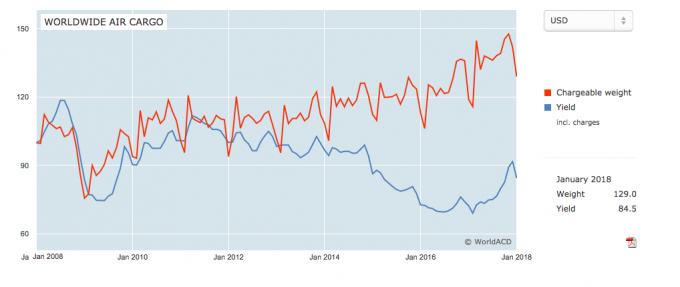Air cargo shifts capacity to where the money is as holiday season begins
Airlines are shifting capacity to Asia Pacific-North America as disruption from China’s forthcoming Golden Week ...
GM: RAISING THE ROOF GGM: IN FULL THROTTLE GZIM: MAERSK BOOST KNIN: READ-ACROSSMAERSK: NOT ENOUGHMAERSK: GUIDANCE UPGRADEZIM: ROLLERCOASTERCAT: HEAVY DUTYMAERSK: CATCHING UP PG: DESTOCKING PATTERNSPG: HEALTH CHECKWTC: THE FALLGXO: DEFENSIVE FWRD: RALLYING ON TAKEOVER TALKODFL: STEADY YIELDVW: NEW MODEL NEEDEDWTC: TAKING PROFIT
GM: RAISING THE ROOF GGM: IN FULL THROTTLE GZIM: MAERSK BOOST KNIN: READ-ACROSSMAERSK: NOT ENOUGHMAERSK: GUIDANCE UPGRADEZIM: ROLLERCOASTERCAT: HEAVY DUTYMAERSK: CATCHING UP PG: DESTOCKING PATTERNSPG: HEALTH CHECKWTC: THE FALLGXO: DEFENSIVE FWRD: RALLYING ON TAKEOVER TALKODFL: STEADY YIELDVW: NEW MODEL NEEDEDWTC: TAKING PROFIT

Air freight rates are expected to have dipped in February, after a reasonably strong start to the year that saw them at their highest January level since 2015.
Drewry’s East-West air freight rate index rose 2% year-on-year in January, but this was 10% down on December numbers, falling $0.30 to $2.76 per kg.
The consultant says it expects February to record a “demand lull”, as Chinese factory closures come into play: “Drewry expects prices to soften again in February,” it said.
Freightos noted, excitedly, that rates this week, post Chinese new year, were “low right now”, adding: “I’m talking close to rock bottom. We haven’t seen prices this good in months – some forwarders have dropped air shipments by $3/kg.”
January figures show that, year on year, air cargo rates seem to have held up since the headiness of 2017, to some extent. Asia-Europe westbound was 11% up on January 2017 and fell just 1% since December.
European carriers have told The Loadstar that transatlantic westbound was “doing well” – and year-on-year rates were up 19%, and only 4% down on December. Transpacific eastbound, which has the highest rates, fell 14% since December and are 1% down, year on year.
WorldACD said yesterday it was too early to fully understand the latest air cargo data, but “at face value, 2018 would seem to be off to a very good start”.
Worldwide volumes were up 8.5%, with at least one-third of the carriers reporting they had seen tonnage grow 10-50%, year on year. Europe and Latin America were both up 11%.
Yields also rose, although as WorldACD noted, a devaluing US dollar “helped considerably” to put dollar yields up 16.8%. In euros, however, yields rose only 1.6%.
However, the consultancy warned: “Volume trends are difficult to interpret, as Chinese New Year (CNY) – a sizeable influence on overall trade – fell on January 28 last year and on February 16 this year.
“CNY normally has two effects on trade: a spike before and diminishing afterwards. And although the negative influence is usually felt during the two weeks following CNY, the first four days (Jan 28-31 in 2017) bear the brunt of the decrease.”
It added that, based on freight tonne km data for the first three weeks, therefore excluding CNY issues, year-on-year volume growth looked to have been about 4-6%.
“A serious growth, surely, but hinting at an overall growth pace lower than the increase shown in the full-January figures.”
WorldACD also looked at specific products and found that the worldwide yield for special cargo – excluding perishables – was 45% higher than for general cargo, a slight drop since the 50% difference of last year.
You can see WorldACD’s full data here.
Comment on this article